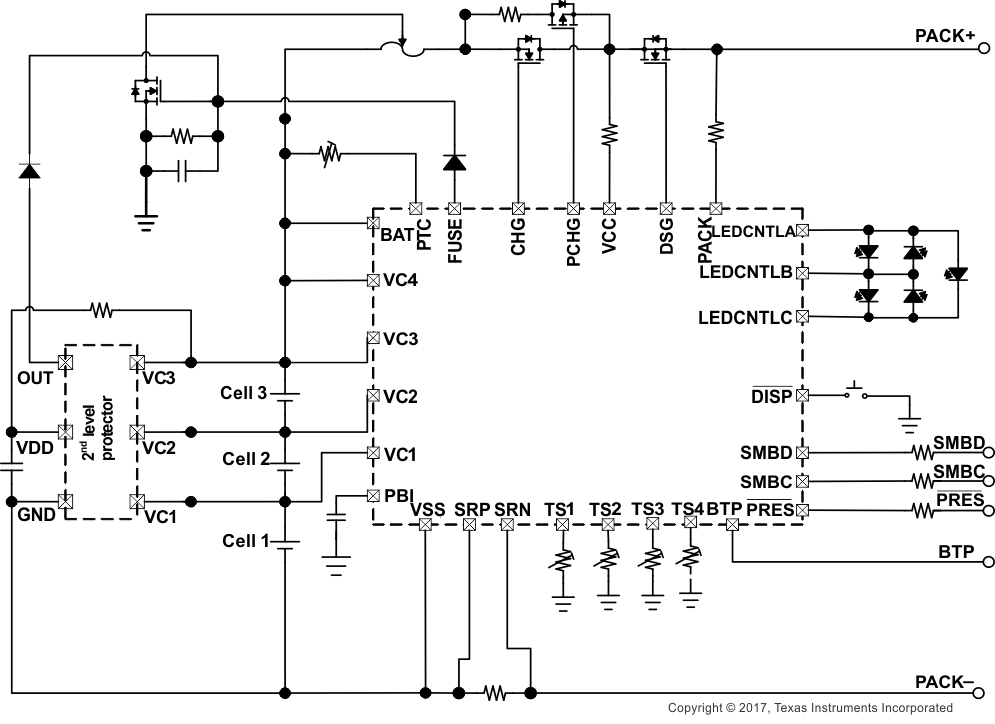ZHCSEW9B March 2016 – October 2017
PRODUCTION DATA.
- 1 特性
- 2 应用
- 3 说明
- 4 修订历史记录
- 5 Pin Configuration and Functions
-
6 Specifications
- 6.1 Absolute Maximum Ratings
- 6.2 ESD Ratings
- 6.3 Recommended Operating Conditions
- 6.4 Thermal Information
- 6.5 Electrical Characteristics: Supply Current
- 6.6 Electrical Characteristics: Power Supply Control
- 6.7 Electrical Characteristics: AFE Power-On Reset
- 6.8 Electrical Characteristics: AFE Watchdog Reset and Wake Timer
- 6.9 Electrical Characteristics: Current Wake Comparator
- 6.10 Electrical Characteristics: VC1, VC2, VC3, VC4, BAT, PACK
- 6.11 Electrical Characteristics: SMBD, SMBC
- 6.12 Electrical Characteristics: PRES, BTP_INT, DISP
- 6.13 Electrical Characteristics: LEDCNTLA, LEDCNTLB, LEDCNTLC
- 6.14 Electrical Characteristics: Coulomb Counter
- 6.15 Electrical Characteristics: CC Digital Filter
- 6.16 Electrical Characteristics: ADC
- 6.17 Electrical Characteristics: ADC Digital Filter
- 6.18 Electrical Characteristics: CHG, DSG FET Drive
- 6.19 Electrical Characteristics: PCHG FET Drive
- 6.20 Electrical Characteristics: FUSE Drive
- 6.21 Electrical Characteristics: Internal Temperature Sensor
- 6.22 Electrical Characteristics: TS1, TS2, TS3, TS4
- 6.23 Electrical Characteristics: PTC, PTCEN
- 6.24 Electrical Characteristics: Internal 1.8-V LDO
- 6.25 Electrical Characteristics: High-Frequency Oscillator
- 6.26 Electrical Characteristics: Low-Frequency Oscillator
- 6.27 Electrical Characteristics: Voltage Reference 1
- 6.28 Electrical Characteristics: Voltage Reference 2
- 6.29 Electrical Characteristics: Instruction Flash
- 6.30 Electrical Characteristics: Data Flash
- 6.31 Electrical Characteristics: OCD, SCC, SCD1, SCD2 Current Protection Thresholds
- 6.32 Timing Requirements: OCD, SCC, SCD1, SCD2 Current Protection Timing
- 6.33 Timing Requirements: SMBus
- 6.34 Timing Requirements: SMBus XL
- 6.35 Typical Characteristics
-
7 Detailed Description
- 7.1 Overview
- 7.2 Functional Block Diagram
- 7.3
Feature Description
- 7.3.1 Primary (1st Level) Safety Features
- 7.3.2 Secondary (2nd Level) Safety Features
- 7.3.3 Charge Control Features
- 7.3.4 Gas Gauging
- 7.3.5 Configuration
- 7.3.6 Battery Parameter Measurements
- 7.3.7 Battery Trip Point (BTP)
- 7.3.8 Lifetime Data Logging Features
- 7.3.9 Authentication
- 7.3.10 LED Display
- 7.3.11 Voltage
- 7.3.12 Current
- 7.3.13 Temperature
- 7.3.14 Communications
- 7.4 Device Functional Modes
- 8 Applications and Implementation
- 9 Power Supply Recommendations
- 10Layout
- 11器件和文档支持
- 12机械、封装和可订购信息
1 特性
- 高侧保护 N 通道 FET 驱动器可在故障期间实现串行总线通信
- 采用内部旁路的电池均衡功能可优化电池健康状况
- 用于故障分析的诊断使用寿命数据监控器和黑盒记录器
- 全面的可编程保护 特性:电压、电流和温度
- JEITA 充电算法支持智能充电
- 具有双路独立模数转换器 (ADC) 的模拟前端
- 同步电流和电压采样
- 高精度库伦计数器,输入偏移误差 < 1µV(典型值)
- 支持电池跳变点 (BTP) 功能,用于 Windows®集成
- LED 显示屏用于充电状态和电池状态指示
- 适用于编程和数据访问的 100KHz SMBus 1.1 版通信接口,具有 400KHz 交替模式
- SHA-1 认证响应器,用于提高电池组安全性
- 紧凑型 32 引脚 VQFN 封装 (RSM)
2 应用
- 笔记本电脑
- 医疗与测试设备
- 便携式仪表
- 无线真空吸尘器和扫地机器人
3 说明
德州仪器 (TI) 的 bq4050 器件采用补偿放电终止电压 (CEDV) 技术,是一款高度集成的高精度 1-4 节电池电量测量仪表和保护解决方案,可实现自主的充电器控制和电池平衡。
bq4050 器件提供一个基于电池组的完全集成式解决方案,该解决方案具备闪存可编程的定制精简指令集 CPU (RISC)、安全保护以及身份验证,适用于锂离子和锂聚合物电池组。
bq4050 电量测量仪表通过一个与 SMBus 兼容的接口进行通信,并将超低功耗的高速 TI bqBMP 处理器、高精度模拟测量功能、集成式闪存存储器、一组外设和通信端口、N 通道 FET 驱动以及 SHA-1 身份验证变换响应器,融合为一个完整的高性能电池管理解决方案。
器件信息(1)
| 器件型号 | 封装 | 封装尺寸(标称值) |
|---|---|---|
| bq4050 | VQFN (32) | 4.00mm x 4.00mm |
- 如需了解所有可用封装,请见产品说明书末尾的可订购产品附录。
简化电路原理图
